The coastline of Austurland is both spectacular and diverse. It features both black and white sandy beaches, beaches with pebbles or rocks, and cliffs rising from the ocean. The beaches in Austurland can easily be a source of recreation, especially for families with children when a trip to the beach can turn into a true adventure.
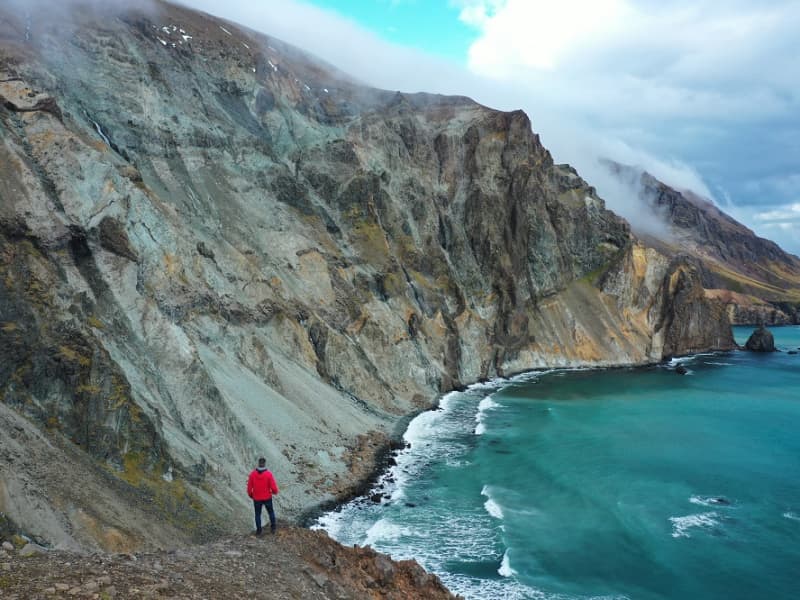
Landsendi
Walk from the sign by the road no 917 towards Ker (before crossing the mountain road Hellisheiði) (N65°42.52- W14°24.41), and from there to Landsendahorn cliff. There one can enjoy a magnificent view of Móvíkur. Above them are 200–300 meters high cliffs and hanging rocky slopes called Móvíkurflug. The rock consists mostly of rhyolite of many colors but mostly yellowish, light brown or greenish grey. The cylinder with the visitors’ log and a stamp is on the banks above Ker.
Part of Hiking Treasures in Egilsstaðir Region
GPS : N65° 43.352-W14°23.300
Powered by Wikiloc
View
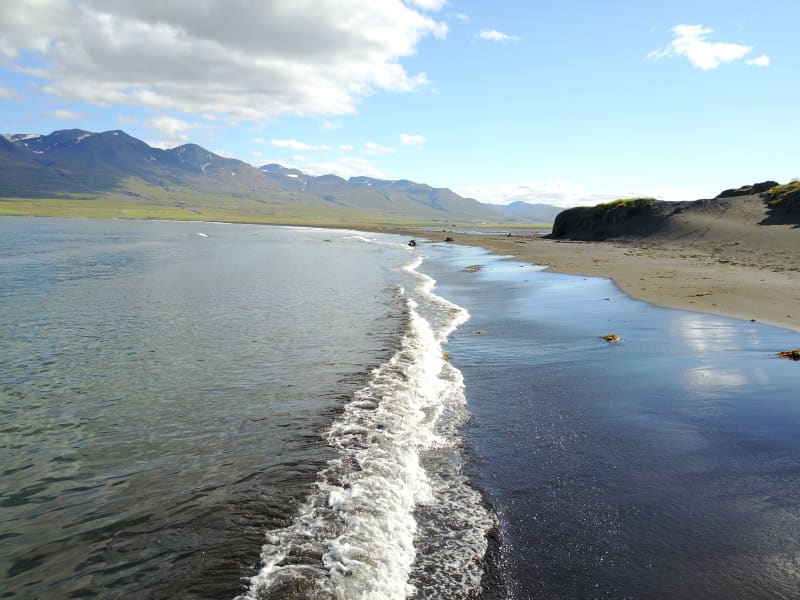
Sandvík in Vopnafjörður
Sandvík is a long, black sandy beach at the innermost part of the fjord. This is a family paradise created by nature. Visitors may find seashells, take a walk, watch the birds, build a sand castle - or follow their own imagination.
Along this coast a supply ship ran aground on 2nd October 1981. All the crew were rescued. At low tide one can still see a glimpse of the wreckage.
Access to Sandvík is by a track down to the bay from near the golf course.
Visitors are reminded to be careful along the beach. The river Hofsá may overrun its banks in the spring, and as a result quicksand can form along the beach.
View
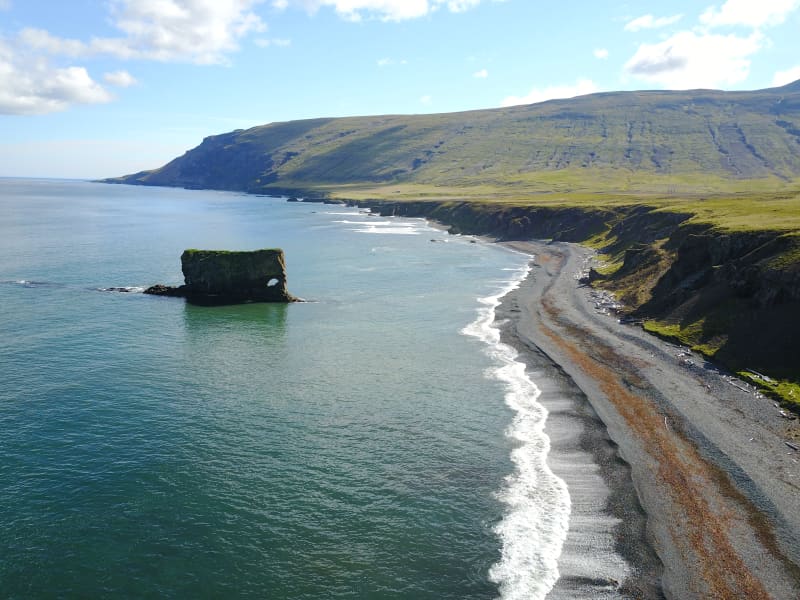
Skjólfjörur black sand beach
Be sure to visit Skjólfjörur beach when driving through Vopnafjörður! The beach is only a short walk from the road and offers a magnificent view of the open Atlantic sea. If you’re lucky, you might even spot a whale. The beach has a rocky shore with colorful stones that capture the eye. Driftwood brought to land by the waves is a testament to the incredible force the sea possesses. Please respect the fact that it is forbidden to remove stones from the beach.
One characteristic of Vopnafjörður is the incredible rock pillars and cliffs that take on various forms, often resembling different creatures. Ljósastapi rock pillar stands out in the sea just off Skjólfjörur. It is often called Fíllinn or the Elephant by locals, as its form resembles an elephant.
To the right of Ljósastapi, the mountain Búrið stands out from the mountain range. Búrið is a part of the Fagradalur mountains, an ancient volcanic area. In the Fagradalur mountains, you can see colorful rhyolite rocks that certainly make their mark on the surrounding environment.
A marked walking path takes you down to Múlahöfn harbour and to Þerribjörg cliffs, east of Hellisheiði eystri, where the rhyoli te is at its most beautiful.
View
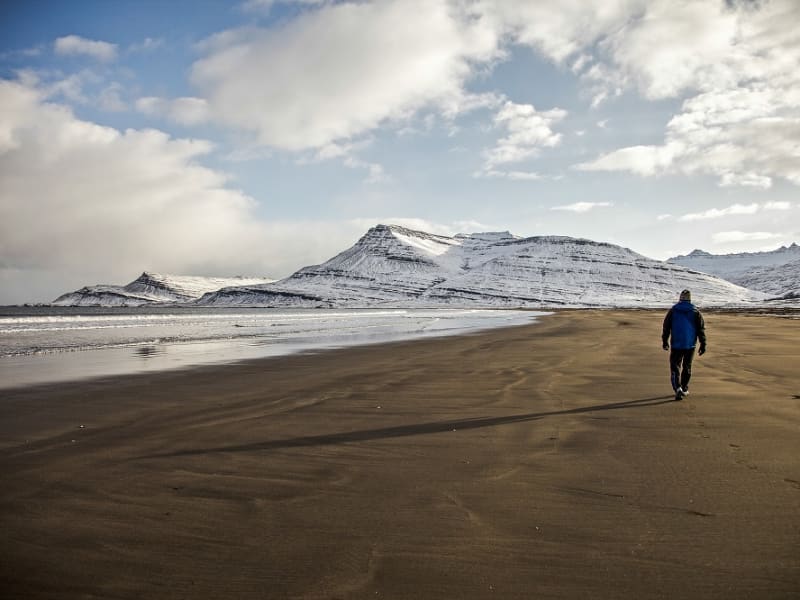
Meleyri
Meleyri is a charming shoreline near Breiðdalsvík. This is an outdoor area, a colorful birdlife arena and popular among locals and tourists alike. The locals use this area a lot, especially during winter because snow des not stick to the sand.
View
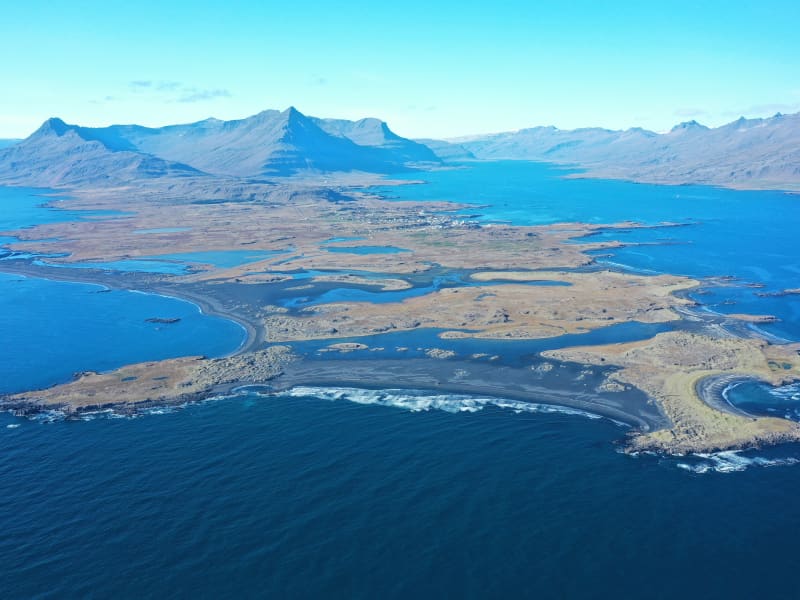
Black Sand Beach in Djúpivogur
The area on Búlandsnes, just outside Djúpivogur, is ideal for hiking, experiencing beauty and adventure, playing, learning, and enjoying a break from the hustle and bustle of everyday life in the spirit of the slow movement, Cittaslow. It features exceptionally beautiful and diverse landscapes, with the colours of black sand, vegetated islets, and mirror-like ponds, rich birdlife, and abundant history. There is also a very scenic view of the mountains and the sea.
You can start the hike by walking east from Djúpivogur, stopping at Bóndavarða (Farmers’ Cairn). From there, you have a fantastic view in all directions, with a viewing disc showing the main place names. Inland, there are many prominent peaks and mountains, with Búlandstindur being one of the most beautiful and famous—a tall and steep pyramid on thesouthern side of Berufjörður. Towards the sea, you see islands and skerries like pearls on a string, with Papey being the largest and most well-known. The surroundings of Djúpivogur are marked by distinctive ridges or high, thin rock formations, standing parallel and giving an enchanting look to the area. These are dikes, ancient solidified lava that filled cracks during volcanic eruptions millions of years ago. Because the rock in these dikes is hard, the Ice Age glacier couldn't level these ridges to the ground.
From Bóndavarða, you can continue northeast along Langatangi cape or head directly east down to the shore and then south to Grunnasund and across it to the sand. Grunnasund may need to be waded or you can take a detour along its end. You can also walk straight out to the sand southward on the road that leads to the airstrip, a route also suitable for driving. The environment on Búlandsnes has changed significantly from earlier times when the islets on the sand were real islands with boat-accessible channels between them.
South of Grunnasund, the route continues into Úlfsey. In the past, when there was a channel between it and the mainland, boats rowed through it. Gradually, the channel shallowed, and sources say it was full of sand over 100 years ago, sometime after 1880. On Úlfsey, there is said to be an ancient burial mound, probably named after a person named Úlfur. "No man shall set foot on land there without singing a verse by the mound, making a prayer, or placing a stone on the mound," according to the folk tales of Jón Árnason. The mound believed to be Úlfshaugur is a half-grown pile of stones in the northeast of Úlfsey.
From Úlfsey, you can walk southeast to Hvaley where you can see, in the southernmost cliffs, a cave, considered a natural formation but filled with sand. It was partially excavated a few years ago but has since filled with sand again. It is believed that people who used the island for egg collecting or as a sheepfold, stayed in the cave.
Continue the hike with a stop at Kálki, where there are ruins of houses, and then out to Sandey. It is possible to scramble down to the shore in Sandey if the tide is low and explore a cave there. To close the loop, you can walk along the airfield to the ponds Fýluvogur and Breiðavogur, but first, you might take a detour west across the sand to Hrísey and Kiðhólmi. According to sources, there were settlements in Hrísey in earlier times, and ruins are visible there. According to records, there was a trading harbor in Fýluvogur, then a navigable cove in the 1500s. German merchants from Bremen traded at Fýluvogur, while Hamburg merchants traded at Djúpivogur. With the establishment of the Danish trade monopoly in 1602, German trade ceased.
At Fýluvogur, there are now birdwatching houses to make it easier for people to observe the diverse and bustling birdlife there. Wetlands, ponds, and shores are ideal for birdwatching, especially in spring when migratory birds arrive and during the breeding season, but there is also a passage of migratory birds through the area in autumn. There are many waders and very diverse duck breeding, such as the gadwall and shoveler. The great crested grebe has also nested by the ponds. Besides the many breeding birds, many waders and ducks pass through the area in spring and autumn, including interesting vagrant birds. In addition to the wetland birds, which are prominent on Búlandsnes, you can see seabirds along the coast, moorland birds on the hills and heaths, and if you go up into Hálsaskógur, a forested area near Djúpivogur, you might encounter the goldcrest, the smallest bird in Europe, and other woodland birds. Hálsar is also an ideal area for hiking and nature observation, featuring diverse and unusual landscapes with distinctive dikes.
View
